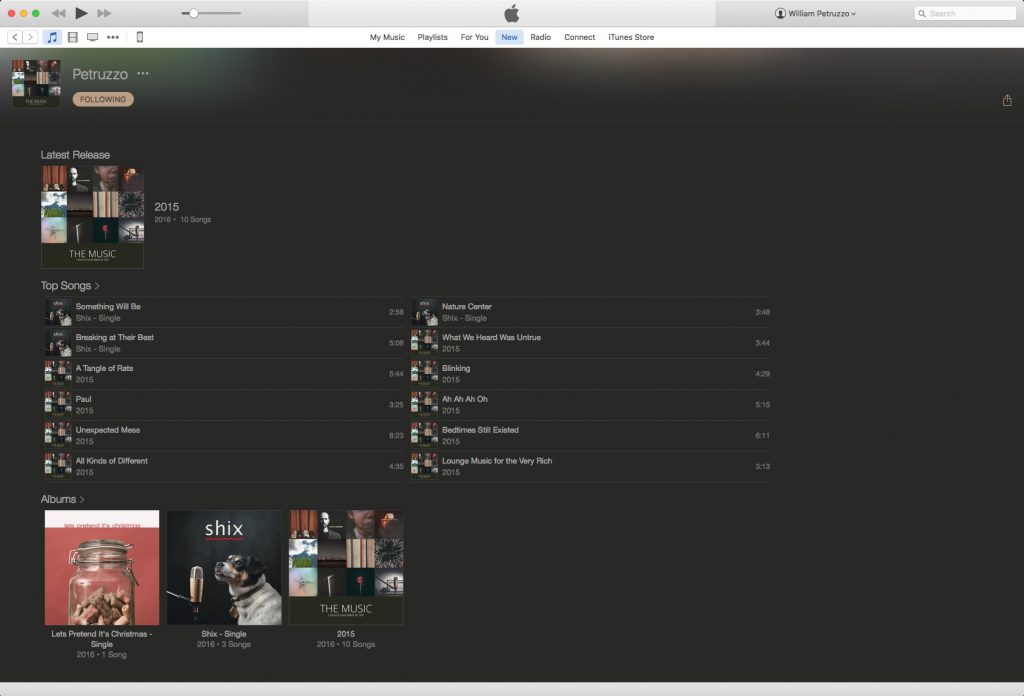
In the last 15 months, I’ve written and recorded 16 songs. I invested hundreds of hours into the project, learning a great deal about how and why music ‘works’. I am, by no stretch of the imagination, an expert or a professional, or even fairly considered a ‘musician’. I’m a musician the same way someone creating a digital collage is a photographer. That is to say, the end result matters, but the process to get there is how we categorize these sorts things.
The music I created is music I like. I can listen to it in the car and enjoy it–however egomaniacal that may appear to be. When I was younger, I’d really latch onto one or two songs at a time. Some little melodic trick, a combination of instruments, or a vocal rhythm, would stick with me and I’d get obsessed with it. Sometimes I’d listen to those tracks dozens of times in a row and eventually start skipping just to the parts I liked to sing along with.
At the time I started the project (and still today), I am surrounded by a lot of artists and musicians in my free time. They provided the motivation and encouragement to give it a try. Jef, Rivka, Nate, Erik, Felipe (who works with me at Petruzzo Photography) to name a few. I also found it motivating that this might provide an opportunity to peer into the processes and challenges of working musicians. If there’s one thing I love, it’s understanding the needs of a ‘market’. Frankly, I’m not so sure I got that out of the project, but those musicians were often on my mind while I was working.
Fundamentally though, this was a project about me, for me. At no point in the process, or today, have I dreamed about ‘making it as a musician’. I haven’t felt an urge to perform for audiences (even though I was invited to perform at a weird little indie festival down in Virginia Beach, I declined). And, as cool as it is to know someone else has listened to my music, I kind of don’t care. For nearly a decade now, to publish my art where someone might find it has been my way of saying “this thing is done”.
Personal art and photography has gone on this website, on SoundCloud, on 500px, Flickr, Instagram; social networking sites, known for their user generated content. “But why,” I can hear you objecting, “If you don’t care about other people hearing this music, would you put it on Spotify?” Well, not just on Spotify, actually. It’s on pretty much all the streaming sites, Apple Music, iTunes, Google Play, Amazon Prime, and a bunch of others. But I digress.
The reason I chose to push my music onto all these services is twofold. First, after hundreds of hours of work, I thought it’d feel cool to be able to type “Petruzzo” into any of the major music services and see what I’d made right there. It does feel cool. But the second, and much more significant reason, is as a kind of challenge to those musicians around me. Let me unpack that.
I don’t listen to very much local music. Yes, even that of some of my closest friends. It’s not that I don’t like their music, most of the time I do. It’s because their music is not found in the places where I listen to music. I never just throw on SoundCloud and listen to tunes. I suspect almost no one, except those invested in the social network of SoundCloud, does. I open Apple Music or Spotify and press shuffle. A comparatively significant amount of energy must be invested in most local music to make sure it occasionally shows up in that list of stuff shuffling.
To me, I see this as frustrating nonsense.
Of all the kinds of popular artforms out there, the music industry makes, perhaps, the most egregious use of the ‘gatekeeper’. You can listen to SoundCloud, or Bandcamp, or ReverbNation… or you can listen to real music on Spotify or iTunes. I hope you’re picking up on the sarcasm. While music, like photos or videos, is digital and should be easy to publish wherever your want, it’s not. You can’t just log in at 3am and upload some song to iTunes and post it on Facebook. You have to jump through hoops to get the proverbial stamp of approval from Apple, or Spotify or whatever. Not even a stamp of quality-approval, it’s a stamp that just says you jumped through all the erroneous hoops.
Five years ago, that “stamp of approval” was hard to get. It meant spending hundreds of dollars on a distributor, or being signed to a record label who would pay hundreds of dollars to a distributor (and then take all the profits). That is not the case anymore. Let me say this again, in case you need to read it bolder. That is not the case anymore.
I paid $20 to Distrokid, a digital distributor, to upload as much or as little as I wanted for an entire year. $20, once a year. That was all. It took all of about 15 minutes to publish everything, and now it’s practically everywhere.
So, about that challenge. To other artists and musicians who are working their ass off and telling people to check out their BandCamp page: You’re putting too much time and energy into what you’re creating not to spend a few bucks, the price of a movie and popcorn, not to push your work into a place where ordinary music listeners can find it.
I know you hustle, you go out and play shows, and try to chip away at the task of building an audience. But what percentage of people at your show do you think can be fairly considered “indie music enthusiasts”; people who hear music for what it is, and invest themselves in enjoying it beyond the excitement of a Thursday evening at the bar? I’m betting it’s about 20%. The other 80% are most likely people who needed a place to drink and enjoy live music when they do.
Now imagine you’re finishing up your set and you say into the microphone, “If you liked our set, you can buy our CD’s at our merch table over there, or on our BandCamp page at www….!” How many people do you think will respond to that? It’s probably going to be some fraction of that 20% of genuine local music enthusiasts. But, imagine if you instead said, “If you liked our set, check out our album anywhere you like to stream music!” What percentage of people do you think will be listening on their drive home? More. It will be a larger fraction of the whole group, not a fraction of a fraction.
“But… But our profits!” You might say, spoken like a true artist. I jest, of course. You’re not getting them anyway. You can no longer sell an appreciation for the music you create. You have to use the music you create to sell something to be appreciated; a live performance experience, a t-shirt, or hoodie. You can use the music you create to build leverage and influence; booking larger shows for bigger audiences, creating royalties on para-music content like a YouTube channel or Periscope feed. The person who likes to own a record, will still purchase a record because they are enjoying something beyond the music itself. And the modern music listener, who doesn’t make music purchases anymore, will still be able to find your music and become part of your audience.
If I can spend a year making music and put it on all these streaming services, with hardly a second thought and next to no serious financial investment, you can and definitely should. And that is the reason you can find my music on those services. Stop thinking what you’re making isn’t good enough and start making sure that the people who think it is good enough can find it when they want to.
If you make music, do it now. Get it up there, and then get back to the hustle. You’ll have removed some significant friction between you and your goal.

This is still really spot on William…maybe more so in 2018.